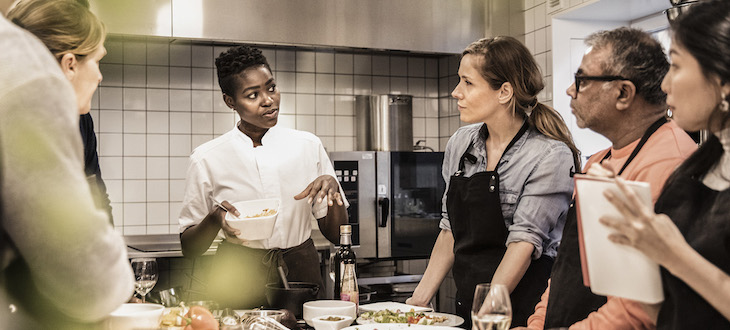With millions of employees across the country, the restaurant and foodservice industry is a tremendously diverse environment. Diversity refers to the great variety of people in today’s world and their backgrounds, experiences, opinions, religions, ages, talents, and abilities. As a member of this dynamic community, you will be expected to respect the differences of your coworkers and guests. The benefits are undeniable – a more pleasant work environment, stronger relationships, and more success for the
entire team. So it is worth spending some time on understanding the forces that can work against diversity.
Stereotypes, Biases, and Prejudices
Stereotypes are GENERALIZATIONS about particular groups based on some kind of information.
These generalizations assume that all members of that group are the same. Stereotypes are hard to change because they are usually not based on actual experience, but on received knowledge in the form of gossip, family lore, social media posts, and all the myriad ways you get ideas.
All people are hurt by stereotyping – those who are being labeled and those who think the labels are true.
People who believe in stereotypes – either positive or negative – are cheated out of genuine relationships with people. Stereotypes cloud their personal and business judgment in untold ways, creating bias and prejudice.
Bias is a TENDENCY toward or against a particular person, perspective, or idea. With a bias, you are leaning towards an opinion, but haven’t taken action upon it. Biases are not necessarily negative, but are almost always considered unfair.
For example, imagine you are a teacher and you see two students fighting. You personally know one of them. So you jump to the conclusion that it was the OTHER student who started the fight. Here you are being biased towards the student you know and against the one you do not. But in reality, you really have no idea who started the fight.
Prejudice is more than a tendency – it is a preconceived OPINION about a person, group, or organization, especially one that is not based on actual experience or reason. Some people are brought up in an environment where they learn to like certain people and groups and dislike others, which is a nice way of saying that they grew up in a home where racism was accepted as normal.
If this all sounds a bit wonky and unclear, check this out:
Few people are comfortable acknowledging their own prejudices and biases. For all of us – every single one – we have racial and cultural preconceptions that keep us from having the best, most rewarding relationships with people of every variety.
Here’s a quick, personal story:
I grew up in a home with powerful stereotypical views towards other racial groups, strong negative biases and prejudices that came up all the time. My roots are in the deep south (we’re talking REALLY deep, here – like backwoods Alabama deep). Racial biases and racial prejudice ruled my household the entire time I was growing up.
A respected chef gave me a stern talk when he heard me talking in a prejudiced and disrespectful way about one of my line cooks. To be honest, he scared me. I wanted to be successful in my career and I wanted the respect of my chef, so I took a hard look at myself and considered my reactions and interactions with those around me. That was tough. I didn’t want to admit that I had unconsciously adopted many of the preconceptions of my mom and dad. Things are very different for me today, but it took time and effort.
Want to learn more? Here’s a great article to dig deeper: Prejudice, Discrimination, and Stereotyping
Showing Empathy and Compassion
You already know about the need to communicate in the workplace. Teams talk to each other, and service staff talk frequently to guests. Your ability to connect with people by listening and showing understanding is another critical skill.
Empathy is the act of identifying with the feelings, thoughts, or attitudes of another person. Empathetic individuals put others at ease with nonjudgmental acceptance. Often it is referred to as “standing in someone else’s shoes.” Sometimes, you can connect with another person’s feelings simply by acknowledging them verbally. For example:
Employee to manager: “Sam called in sick again today. He’s been out a lot lately. It’s been hard on all of us!”
Manager to employee: “I know that it’s been tough on you and the rest of the team. I appreciate that you’ve all been pitching in to keep everything running smoothly. I’m working on this situation so that it won’t continue to be a problem.”
In this scenario, the manager acknowledged the employee’s feelings and made it clear that she understood how difficult the situation was. The manager showed empathy for the employee’s frustration.
By using empathic statements in your communication with other people at work, you have the chance to show genuine concern about the people you work with and an understanding of their needs and feelings. This communication and understanding can help ensure you are able to connect with your coworkers
in a positive way. This will help you build trust and respect with others – a particularly important skill once you become a manager who is responsible for building strong teams.
But let’s be honest: for most of my students, they have to learn how to simply be KIND before they need to worry about being EMPATHETIC. Empathy and Compassion is like trigonometry and being nice is like basic Algebra…. and lot’s of them are struggling with Algebra.
Be nice. Be freakin’ nice, for god’s sake!
It won’t kill you to pretend to like the people you work with.





